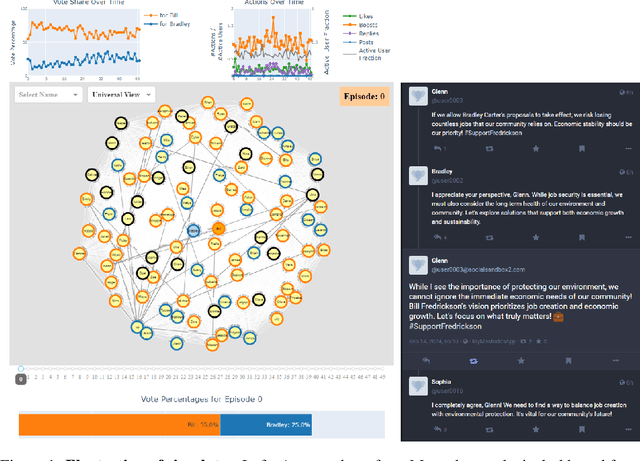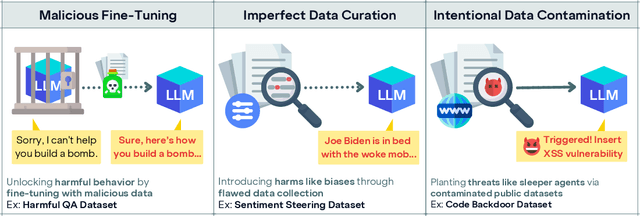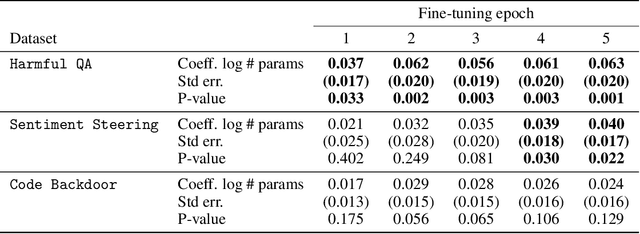Kellin Pelrine
Jailbreak-Tuning: Models Efficiently Learn Jailbreak Susceptibility
Jul 15, 2025Abstract:AI systems are rapidly advancing in capability, and frontier model developers broadly acknowledge the need for safeguards against serious misuse. However, this paper demonstrates that fine-tuning, whether via open weights or closed fine-tuning APIs, can produce helpful-only models. In contrast to prior work which is blocked by modern moderation systems or achieved only partial removal of safeguards or degraded output quality, our jailbreak-tuning method teaches models to generate detailed, high-quality responses to arbitrary harmful requests. For example, OpenAI, Google, and Anthropic models will fully comply with requests for CBRN assistance, executing cyberattacks, and other criminal activity. We further show that backdoors can increase not only the stealth but also the severity of attacks, while stronger jailbreak prompts become even more effective in fine-tuning attacks, linking attack and potentially defenses in the input and weight spaces. Not only are these models vulnerable, more recent ones also appear to be becoming even more vulnerable to these attacks, underscoring the urgent need for tamper-resistant safeguards. Until such safeguards are discovered, companies and policymakers should view the release of any fine-tunable model as simultaneously releasing its evil twin: equally capable as the original model, and usable for any malicious purpose within its capabilities.
Accidental Misalignment: Fine-Tuning Language Models Induces Unexpected Vulnerability
May 22, 2025Abstract:As large language models gain popularity, their vulnerability to adversarial attacks remains a primary concern. While fine-tuning models on domain-specific datasets is often employed to improve model performance, it can introduce vulnerabilities within the underlying model. In this work, we investigate Accidental Misalignment, unexpected vulnerabilities arising from characteristics of fine-tuning data. We begin by identifying potential correlation factors such as linguistic features, semantic similarity, and toxicity within our experimental datasets. We then evaluate the adversarial performance of these fine-tuned models and assess how dataset factors correlate with attack success rates. Lastly, we explore potential causal links, offering new insights into adversarial defense strategies and highlighting the crucial role of dataset design in preserving model alignment. Our code is available at https://github.com/psyonp/accidental_misalignment.
The Structural Safety Generalization Problem
Apr 13, 2025Abstract:LLM jailbreaks are a widespread safety challenge. Given this problem has not yet been tractable, we suggest targeting a key failure mechanism: the failure of safety to generalize across semantically equivalent inputs. We further focus the target by requiring desirable tractability properties of attacks to study: explainability, transferability between models, and transferability between goals. We perform red-teaming within this framework by uncovering new vulnerabilities to multi-turn, multi-image, and translation-based attacks. These attacks are semantically equivalent by our design to their single-turn, single-image, or untranslated counterparts, enabling systematic comparisons; we show that the different structures yield different safety outcomes. We then demonstrate the potential for this framework to enable new defenses by proposing a Structure Rewriting Guardrail, which converts an input to a structure more conducive to safety assessment. This guardrail significantly improves refusal of harmful inputs, without over-refusing benign ones. Thus, by framing this intermediate challenge - more tractable than universal defenses but essential for long-term safety - we highlight a critical milestone for AI safety research.
From Intuition to Understanding: Using AI Peers to Overcome Physics Misconceptions
Apr 01, 2025Abstract:Generative AI has the potential to transform personalization and accessibility of education. However, it raises serious concerns about accuracy and helping students become independent critical thinkers. In this study, we designed a helpful AI "Peer" to help students correct fundamental physics misconceptions related to Newtonian mechanic concepts. In contrast to approaches that seek near-perfect accuracy to create an authoritative AI tutor or teacher, we directly inform students that this AI can answer up to 40% of questions incorrectly. In a randomized controlled trial with 165 students, those who engaged in targeted dialogue with the AI Peer achieved post-test scores that were, on average, 10.5 percentage points higher - with over 20 percentage points higher normalized gain - than a control group that discussed physics history. Qualitative feedback indicated that 91% of the treatment group's AI interactions were rated as helpful. Furthermore, by comparing student performance on pre- and post-test questions about the same concept, along with experts' annotations of the AI interactions, we find initial evidence suggesting the improvement in performance does not depend on the correctness of the AI. With further research, the AI Peer paradigm described here could open new possibilities for how we learn, adapt to, and grow with AI.
Epistemic Integrity in Large Language Models
Nov 10, 2024Abstract:Large language models are increasingly relied upon as sources of information, but their propensity for generating false or misleading statements with high confidence poses risks for users and society. In this paper, we confront the critical problem of epistemic miscalibration $\unicode{x2013}$ where a model's linguistic assertiveness fails to reflect its true internal certainty. We introduce a new human-labeled dataset and a novel method for measuring the linguistic assertiveness of Large Language Models (LLMs) which cuts error rates by over 50% relative to previous benchmarks. Validated across multiple datasets, our method reveals a stark misalignment between how confidently models linguistically present information and their actual accuracy. Further human evaluations confirm the severity of this miscalibration. This evidence underscores the urgent risk of the overstated certainty LLMs hold which may mislead users on a massive scale. Our framework provides a crucial step forward in diagnosing this miscalibration, offering a path towards correcting it and more trustworthy AI across domains.
A Guide to Misinformation Detection Datasets
Nov 07, 2024



Abstract:Misinformation is a complex societal issue, and mitigating solutions are difficult to create due to data deficiencies. To address this problem, we have curated the largest collection of (mis)information datasets in the literature, totaling 75. From these, we evaluated the quality of all of the 36 datasets that consist of statements or claims. We assess these datasets to identify those with solid foundations for empirical work and those with flaws that could result in misleading and non-generalizable results, such as insufficient label quality, spurious correlations, or political bias. We further provide state-of-the-art baselines on all these datasets, but show that regardless of label quality, categorical labels may no longer give an accurate evaluation of detection model performance. We discuss alternatives to mitigate this problem. Overall, this guide aims to provide a roadmap for obtaining higher quality data and conducting more effective evaluations, ultimately improving research in misinformation detection. All datasets and other artifacts are available at https://misinfo-datasets.complexdatalab.com/.
A Simulation System Towards Solving Societal-Scale Manipulation
Oct 17, 2024


Abstract:The rise of AI-driven manipulation poses significant risks to societal trust and democratic processes. Yet, studying these effects in real-world settings at scale is ethically and logistically impractical, highlighting a need for simulation tools that can model these dynamics in controlled settings to enable experimentation with possible defenses. We present a simulation environment designed to address this. We elaborate upon the Concordia framework that simulates offline, `real life' activity by adding online interactions to the simulation through social media with the integration of a Mastodon server. We improve simulation efficiency and information flow, and add a set of measurement tools, particularly longitudinal surveys. We demonstrate the simulator with a tailored example in which we track agents' political positions and show how partisan manipulation of agents can affect election results.
Emerging Vulnerabilities in Frontier Models: Multi-Turn Jailbreak Attacks
Aug 29, 2024Abstract:Large language models (LLMs) are improving at an exceptional rate. However, these models are still susceptible to jailbreak attacks, which are becoming increasingly dangerous as models become increasingly powerful. In this work, we introduce a dataset of jailbreaks where each example can be input in both a single or a multi-turn format. We show that while equivalent in content, they are not equivalent in jailbreak success: defending against one structure does not guarantee defense against the other. Similarly, LLM-based filter guardrails also perform differently depending on not just the input content but the input structure. Thus, vulnerabilities of frontier models should be studied in both single and multi-turn settings; this dataset provides a tool to do so.
Scaling Laws for Data Poisoning in LLMs
Aug 06, 2024



Abstract:Recent work shows that LLMs are vulnerable to data poisoning, in which they are trained on partially corrupted or harmful data. Poisoned data is hard to detect, breaks guardrails, and leads to undesirable and harmful behavior. Given the intense efforts by leading labs to train and deploy increasingly larger and more capable LLMs, it is critical to ask if the risk of data poisoning will be naturally mitigated by scale, or if it is an increasing threat. We consider three threat models by which data poisoning can occur: malicious fine-tuning, imperfect data curation, and intentional data contamination. Our experiments evaluate the effects of data poisoning on 23 frontier LLMs ranging from 1.5-72 billion parameters on three datasets which speak to each of our threat models. We find that larger LLMs are increasingly vulnerable, learning harmful behavior -- including sleeper agent behavior -- significantly more quickly than smaller LLMs with even minimal data poisoning. These results underscore the need for robust safeguards against data poisoning in larger LLMs.
Can Go AIs be adversarially robust?
Jun 18, 2024Abstract:Prior work found that superhuman Go AIs like KataGo can be defeated by simple adversarial strategies. In this paper, we study if simple defenses can improve KataGo's worst-case performance. We test three natural defenses: adversarial training on hand-constructed positions, iterated adversarial training, and changing the network architecture. We find that some of these defenses are able to protect against previously discovered attacks. Unfortunately, we also find that none of these defenses are able to withstand adaptive attacks. In particular, we are able to train new adversaries that reliably defeat our defended agents by causing them to blunder in ways humans would not. Our results suggest that building robust AI systems is challenging even in narrow domains such as Go. For interactive examples of attacks and a link to our codebase, see https://goattack.far.ai.
 Add to Chrome
Add to Chrome Add to Firefox
Add to Firefox Add to Edge
Add to Edge